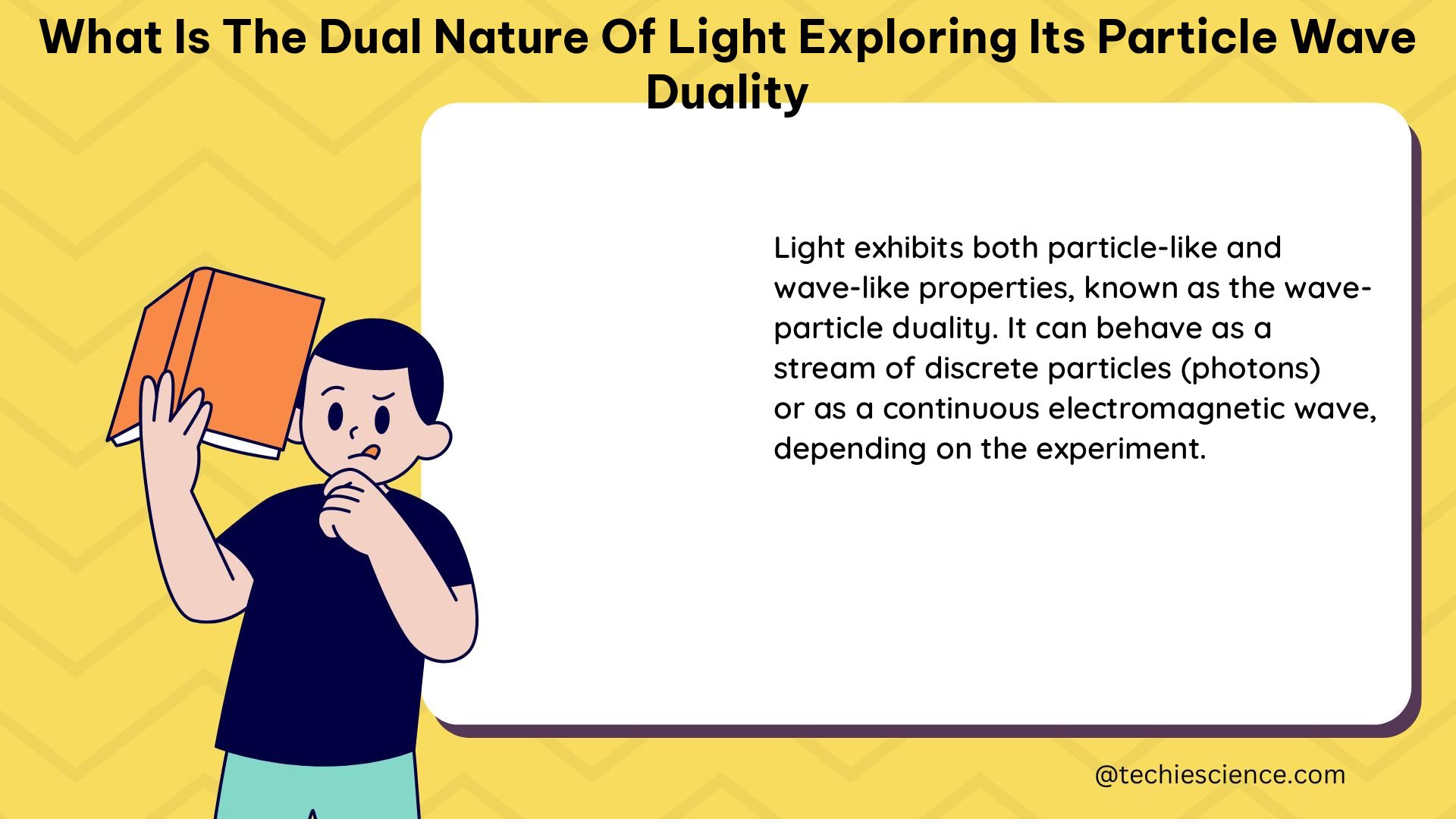The dual nature of light, also known as wave-particle duality, is a fundamental concept in quantum mechanics that describes the paradoxical behavior of light as both a wave and a particle, depending on the experimental conditions. This phenomenon has been a subject of intense study and debate in the scientific community, and it has profound implications for our understanding of the physical world.
The Wave-Like Properties of Light
The wave-like properties of light are characterized by its wavelength (λ) and frequency (ν), which are related by the speed of light equation: c = λν, where c is the speed of light. These wave-like properties are observed in various phenomena, such as:
- Interference: When light passes through two slits, it creates an interference pattern on a screen, which is a characteristic of wave behavior. This is demonstrated in the famous double-slit experiment.
- Diffraction: Light can bend around the edges of obstacles or apertures, a phenomenon known as diffraction, which is also a wave-like property.
- Polarization: Light can be polarized, meaning that the electric field oscillates in a specific direction, which is a wave-like property.
The Particle-Like Properties of Light

The particle-like properties of light are characterized by its energy, which is given by the equation E = hf, where h is Planck’s constant and f is the frequency of the light. These particle-like properties are observed in various phenomena, such as:
- Photoelectric Effect: When light strikes a metal surface, it can eject electrons from the surface, a phenomenon known as the photoelectric effect. This effect can only be explained by the particle-like nature of light, as proposed by Albert Einstein.
- Compton Scattering: When high-energy photons collide with electrons, the photons can transfer some of their energy to the electrons, a process known as Compton scattering. This effect can only be explained by the particle-like nature of light.
- Blackbody Radiation: The distribution of energy in the spectrum of blackbody radiation can only be explained by the particle-like nature of light, as proposed by Max Planck.
The Double-Slit Experiment
The double-slit experiment is one of the most famous demonstrations of the wave-particle duality of light. In this experiment, light is passed through two narrow slits, and the resulting interference pattern on a screen is observed. When the intensity of the light is reduced to the point where only one photon is passing through the slits at a time, the interference pattern still appears, indicating that the photon is behaving as a wave.
This phenomenon is known as the “which-way” experiment, and it demonstrates that the photon is interfering with itself. The photon seems to be passing through both slits simultaneously, even though it is detected as a single particle.
The De Broglie Hypothesis
The concept of wave-particle duality was first introduced by Louis de Broglie in his PhD thesis in 1924. De Broglie proposed that all matter, not just light, has wave-like properties. This hypothesis was later confirmed experimentally, and it led to the development of quantum mechanics.
According to de Broglie’s hypothesis, the wavelength of a particle is given by the equation λ = h/p, where λ is the wavelength, h is Planck’s constant, and p is the momentum of the particle. This equation has been verified experimentally for a wide range of particles, including electrons, neutrons, and even large molecules.
Quantum Mechanical Interpretation
The wave-particle duality of light and matter is a fundamental aspect of quantum mechanics, and it has led to the development of the wave function and the probabilistic interpretation of quantum mechanics.
In quantum mechanics, the state of a particle is described by a wave function, which is a mathematical function that represents the probability of finding the particle in a particular state. The wave function can exhibit both wave-like and particle-like behavior, depending on the experimental conditions.
The probabilistic interpretation of quantum mechanics states that the wave function does not represent the actual state of the particle, but rather the probability of finding the particle in a particular state. This interpretation has been extensively tested and verified experimentally, and it has led to the development of many important applications, such as quantum computing and quantum cryptography.
Conclusion
The dual nature of light, as both a wave and a particle, is a fundamental concept in quantum mechanics that has profound implications for our understanding of the physical world. The wave-particle duality of light and matter has been extensively studied and verified experimentally, and it has led to the development of many important applications in various fields of science and technology.
References:
- HyperPhysics. (n.d.). Wave-Particle Duality. Retrieved from http://hyperphysics.phy-astr.gsu.edu/hbase/mod1.html
- Phys.LibreTexts. (2022). The Particle-Wave Duality of Light. Retrieved from https://phys.libretexts.org/Bookshelves/College_Physics/College_Physics_1e_%28OpenStax%29/29:_Introduction_to_Quantum_Physics/29.05:_The_Particle-Wave_Duality_of_Light
- Space.com. (2022). The double-slit experiment: Is light a wave or a particle? Retrieved from https://www.space.com/double-slit-experiment-light-wave-or-particle
- Wikipedia. (2022). Wave-particle duality. Retrieved from https://en.wikipedia.org/wiki/Wave%E2%80%93particle_duality
- PhotonTerrace. (n.d.). The wave-particle duality of photons. Retrieved from https://photonterrace.net/en/photon/duality/

The lambdageeks.com Core SME Team is a group of experienced subject matter experts from diverse scientific and technical fields including Physics, Chemistry, Technology,Electronics & Electrical Engineering, Automotive, Mechanical Engineering. Our team collaborates to create high-quality, well-researched articles on a wide range of science and technology topics for the lambdageeks.com website.
All Our Senior SME are having more than 7 Years of experience in the respective fields . They are either Working Industry Professionals or assocaited With different Universities. Refer Our Authors Page to get to know About our Core SMEs.